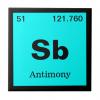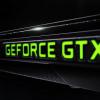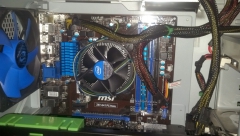Search the Community
Showing results for tags 'intel'.
-
So I ordered an Intel i5-8400 today from newegg and instead an intel i5-8500 came in the mail. Anyone got any info on this because i never heard of it? Possibly rebranded i5-8400 or typo? I can't find any benchmarks or reviews on youtube or google on it and I definitely am not returning it lol Edit: Found a review in french. It is just a lazy rebrand with a slightly higher core clock.
- 5 replies
-
- 5
-

-

-
- Intel
- Yoyos hamster
-
(and 2 more)
Tagged with:
-
Hello guys, currently I own following parts: UserBenchmarks: Game 21%, Desk 45%, Work 27% CPU: Intel Core i5-750 GPU: AMD HD 5770 SSD: Intel 520 Series 180GB HDD: WD Blue 1TB (2015) HDD: WD Black 2TB (2013) HDD: Seagate Barracuda 7200.10 320GB RAM: Unknown 8GB MBD: MSI P55-CD53 (MS-7586) PSU: 550W I want to move to socket 1151, so I need new MBO, CPU and RAM. I already have RAM (Patriot Viper4 2x8 GB 2800Mhz CL16), and regarding CPU I am thinking of between i5 6500K or i5 6600K. My main concern is MBO. This is what I want: ATX format CHIPSET: Z170 or C236 (or better) STORAGE: 1-2 M.2 slot(s) on PCIe lane connector outside the raid for OS (cause I run multiple native OS) 6-8 SATA3 connectors for data storage in RAID 5 or 6 (no software RAID!) AUDIO: ALC1150 or better RAM: 4 slots, capacity 32GB or more So far, I am thinking about MSI Z170A Gaming M5, but if anyone has a better proposition, please be my guest. I am kind of in a hurry, so please be quick! (thanx!)
- 6 replies
-
- intel
- socket 1151
-
(and 1 more)
Tagged with:
-
The world smallest gaming cylinder, the Vortex measures only 10.5 inches tall but can blast away bigger systems with an unlocked Intel Core i7 6700K processor, up to 64 GB of DDR4 memory, SSDs in Super RAID 4, and dual NVIDIA GeForce GTX 980 GPUs in SLI. MSI's newest tower is also engineered for superior upgradability, expandability, and compatibility with a variety of connectors, including Thunderbolt 3 that supports up to 40 GBs of data transfer rate. Minimal in footprint but maximum in performance, the Vortex features MSI's 360° Silent Storm Cooling technology to ensure extreme coolness under the most intense gaming sessions. MSI's cooling system creates a vortex-shaped wind path by capturing heat from the bottom of the unit and circulating it upwards, resulting in superior thermals and acoustics. The 450W 80 plus Gold power supply is also built into the Vortex to minimize space to completely power the system and any peripherals you want to connect. "The revolutionary Vortex gaming tower shatters the misconception that bigger systems deliver more power and performance," says Andy Tung, president of MSI Pan America. "The groundbreaking system maximizes space and heat dissipation to unlock the power of its components for truly astronomical performance in a Subwoofer size." MSI's Vortex can simultaneously support up to six video outputs for intense multi-tasking and multi-screen experiences, is 4K ready, delivers lag-free gaming with Killer DoubleShot X3 connectivity, and an immersive multimedia experience with Nahimic Military X Gaming, the first audio technology adopted by the French Army to vividly reproduce audio in their aircraft training simulators. Perfect as a gaming desktop in the bedroom or as an entertainment station in the living room, MSI's Vortex can be customized and controlled using the Dragon Center Dashboard and App. Through the software, users can customize lightning preferences, monitor system performance, launch utilities and apps, fine-tune the system with personalized profiles, and more. source: guru3d.com The Vortex is now available in USA, starting at $2,199.99. tax free. It shall also be avaible in Europe at something like 2300 euros (with taxes). But not with the two 980GTX, but with two 960GTX, and not 64GB of RAM, but 16GB. Overwise this high config described will be around 3600 US dollars, which would be around 4000 euros taxes included.
-
Some Intel Skylake CPUs are literally bending under the weight of heavy aftermarket CPU coolers. Or, more specifically, the pressure exerted by some coolers seems to be causing damage to Skylake chips. The likely culprit: Intel used a thinner wafer on Skylake CPUs than past chips. According to Intel, the thinner substrate is still rated for the same 50 pound static load, but this issue is definitely real: we've experienced it ourselves. SKYLAKE THICKNESS Skylake CPU comparison Left: Haswell CPU. Right: Skylake CPU. Note the thinner wafer on Skylake. Recently, while moving a Skylake i7-6700K between two systems, our colleagues at Maximum PC experienced this exact bending issue. The damage was caused by installing either an EK-XLC Predator 240, Deep Cool _ or Corsair H90 liquid cooler. We thought too much force had been applied to the chip by installing one of those coolers with an electric screwdriver. It's still possible that the screwdriver applied a damaging amount of force and the damage was user error, but we've never experienced a similar issue on older Intel CPUs with thicker wafers. PC Games Hardware in Germany first reported on the problem on November 30, and several aftermarket cooler makers have commented on the issue. Arctic recommends removal of the CPU cooler for transport (if the system is dropped, a heavy cooler could apply a damaging amount of force to the chip). The pins, motherboard contacts and even the CPU itself can be bent, especially if your PC experiences any bumps. EK and NZXT told Tom's Hardware that their coolers are fully compliant with Intel's force regulations, but both recommended against using older generation coolers that may apply too much pressure. Scythe has said on its support website that it is reducing the mounting pressure of its coolers for Skylake by adjusting the screw set. It will be sending a new set of screws to its customers free of charge. Intel told Tom's Hardware it's investigating the issue. We've reached out to Corsair with a request for comment and will update when we hear back. If you're installing a Skylake CPU anytime soon, be gentle. Source http://www.pcgamer.com/intel-skylake-cpus-are-bending-under-the-pressure-of-some-coolers/
-
Sunday, November 15 marked the 44th anniversary of the Intel 4004, which was the company's first commercially available microprocessor. The 4-bit microprocessor was used in the likes of calculators and taxi meters (however its usage in Pioneer 10, the first spacecraft to leave our solar system, is sadly a myth). There is an Intel 4004 45th Anniversary website, and they have been recreating the complete set of VLSI (very large scale integration, a process for creating integrated circuits) mask artwork of the 4004. The goal of the website's project is to teach people about microprocessor basics, and the 4004 is ideal for doing so because of its minimal design. Tim McNerney "took a pair of high-resolution photomicrographs and set out to trace every wire, transistor, resistor, and capacitor using Adobe Illustrator." The large scale composite of the artwork you can see below will be a lot better for teaching than their previous artwork. There's also an update to the project that saw the creation of a replica of the Busicom 141-PF calculator (the first commercial product to use a microprocessor). They are currently working on "Revision 2," with "corrections and improvements." You can also read a bit about the Intel 4004 on Intel's website, which helps highlight how far microprocessors have come over the years. Intel writes that the fingernail-sized 4004 "delivered the same computing power as the first electronic computer built in 1946, which filled an entire room." But we've come a long way since then. The 4004 was built on a two-inch wafter that held 2300 transistors. Today's Skylake processors? Over 1.3 billion. Source http://www.pcgamer.com/intels-first-microprocessor-the-4004-is-44-years-old/
-
- 1
-

-
n August 2014, Intel released the first Haswell-E processor, the Core i7-5960X. Unlike its predecessors, the Core i7-5960X jumped to eight cores and 16 threads — but the lower clock speeds that this required paradoxically made the chip a less-than-great alternative for gamers. In many titles, the 4.4GHz clock speed on the Core i7-4790K was a better gaming option than the eight cores but lower top-end clock speed (3GHz base, 3.5GHz Turbo) that the 5960X offered. Intel is now working on the successor to Haswell-E, and if recent rumors are true, the company is going to address this discrepancy with the upcoming Broadwell-E. The upcoming family will launch with multiple SKUs that should address the needs of both gamers and other high-end users who have more use for threads and less for clock speed. According to Chinese site XFastest, the Core i7-6950X will be a 10-core, 20-thread CPU with a base clock of 3GHz, an unknown Turbo frequency, and 25MB of L3 cache. That’s two more cores than the current Core i7-5960X, with an equivalent clock speed and the same cache allocation on a per-core basis. Haswell-E had three SKUs — the 5960X at 3GHz base / 3.5GHz Turbo with 8 cores, the 5930K at 3.5GHz base – 3.7GHz Turbo with six cores, and the 5820K at 3.3GHz base – 3.6GHz Turbo, with six cores. The 5960X had 20MB of L3, while the other two chips had 15MB each. This chart implies that Intel will subdivide the market further, with an eight-core, 20MB chip at 3.3GHz, and a brace of six-core chips at 3.6GHz and 3.4GHz respectively, each with 15MB of L3 cache. The implications, if true, suggest that Intel wants to target enthusiasts hunting for more clock speed as well as those who may benefit from having more threads. When Intel first announced that Haswell-E would move to an eight-core top-end configuration, there was some speculation that Intel might bring six-core chips to the conventional desktop line. So far, that hasn’t happened, and it’s not clear if it will, given the current realities of CPU design and the overall state of multi-threading in desktop applications. The four-core / eight-thread configuration that Intel has preferred since it launched Nehalem back in 2008 continues to offer an excellent overall balance of clock speed and performance, even if performance gains have materialized more slowly than we like. There’s little point, however, in pushing end-users towards higher core-counts for their own sake. DirectX 12 could offer additional support for multi-threaded CPU cores. But given that laptops outnumber desktops and laptops are still almost entirely dual-core + Hyper-Threading, we don’t see developers falling over themselves to make games that take advantage of 10-12 cores. Broadwell-E is expected to be compatible with Haswell-E motherboards, though we will likely see a chipset refresh and renewed push from the regular suspects. Broadwell-E should be a drop-in replacement for Haswell-E, but Skylake-E, when it eventually appears, will likely require a new motherboard. Source http://www.extremetech.com/computing/218050-intel-reportedly-prepping-10-core-broadwell-e-processors-with-25mb-l3-cache
-
Nvidia has announced the Jetson TX1, a 64-bit ARM board. Yeah, we know: ARM processors are for phones and tablets, not full PCs. But before you switch off, pay some attention to the TX1: it seems like the gap is rapidly closing between ARM and x86, which has been the go-to for computing for decades. According to Phoronix, Nvidia is even saying that the Jetson TX1 matches up to an Intel Core i7 6700K in some aspects of its performance. When the Jetson TK1 came out last year, it appeared that developers were using it as a production board. Now, after Nvidia announced the Tegra X1 (currently being used in tech such as Nvidia Shield), it is going to be releasing a Jetson based on that, which the company claims will have two to three times the performance of the TK1. According to AnandTech, the Jetson TX1 comes as a standalone module with a separate carrier board for I/O. Attached to the board is 4GB of memory, a 16GB flash module, a 2x2 802.11ac plus Bluetooth wireless radio, and a Gigabit Ethernet controller. The complete TX1 system is on a chip that's a bit smaller than a credit card. The separate I/O carrier board contains all sorts of connectors that will be useful for developers. The JTX1 runs on Nvidia's Maxwell architecture, and contains 256 CUDA graphics cores offering over 1TFLOPs of performance. Nvidia is targeting deep learning, computer vision, and GPU computing with this new board. This means that compute-intensive of an application can be passed off to the GPU, rather than bogging down the CPU. Basically, applications will run more efficiently, which is good news for gamers. You won't just be able to slap a Windows install on it right away, but it could pave the way for cheap, all-in-one Linux gaming systems. Or even the return of Windows RT, but actually good this time? Nvidia is currently taking pre-orders for $600, with the Jetson TX1 and the full development kit expected to start shipping on November 16. The standalone TX1 module will go on sale in Q1 2016, and will be available for $300 (in quantities of 1,000). Source http://www.pcgamer.com/nvidias-arm-jetson-tx1-can-actually-compete-with-an-intel-i7-6700k/
-
Hey there, In the past, I've used various linux distributions such as BackTrack/Kali, BlackArch, ArchAssult, Fedora Security, etc. to run penetration tests and other shady things without an issue. But in particular I've been using the aircrack suite for probably close to 4-5 years now and I have yet to run into this problem. So here's the skinny: I got a ThinkPad obsession back in January, and just not too long ago, a Lenovo TP T60 (Type 2007) was gifted to me, and because the number of jobs that I have had lately requiring forensics tools, pen testing, etc, I was needing a dedicated mobile machine for such purposes. So it came to me with Windows XP and the recovery (Lenovo R+R) partition was all in Chinese... so I formatted that garbage off, and I got into booting various live environments to see what worked best for me. Kali Linux: Nogo. Too commercial/branding in your face. Wireless did not work (could only monitor) OOTB. Fedora 21: Nogo. Goddamit anaconda, can't you work for a change? Crunchbang almost worked for me... As did Blackarch. And so I tried out Manjaro with LXDE. Now on Kali, blackarch and crunchbang, the aircrack suite worked perfectly. But the reason why I mention these different distros is for a reason. Kali's (Debian) wireless interface came up as wlan0. Crunchbang (arch): wlan0. Blackarch (...):wls3. Manjaro: (arch): wls3. So I'm guessing that is because of the integration of systemd, or driver differences (ipl3945 firmware loaded vs not loaded). So what I did was I added the blackarch repository to Manjaro after using my google-fu, and discovering that other people have done so (I still wish I came up with the idea first). After some newbie fiddling around with pacman, I got some tools installed from the blackarch repo, and I proceeded to run them: airmon-ng start wls3 -> works just fine. Sometimes if I've stopped it during the same user session, I have to run it twice to get it to generate a mon1, as mon0 gives me error to start airmon. The next command, airodump-ng mon1 generates-> "ioctl(SIOCSIFFLAGS) failed: Name not unique on network". And this is where I reside stuck at the moment. I did some googling and edited my hosts file based on something that worked for two people: # # /etc/hosts: static lookup table for host names # #<ip-address> <hostname.domain.org> <hostname> 127.0.0.1 paradigm ::1 localhost.localdomain localhost # End of file Where paradigm (the name of my computer) replaces the localhost.localdomain entry- thus pointing the loopback at the correct "network". I'm thinking I'm missing something here though... hosts files have never been my cup of tea. Any and all help is appreciated! Here is output of lspci: 00:00.0 Host bridge: Intel Corporation Mobile 945GM/PM/GMS, 943/940GML and 945GT Express Memory Controller Hub (rev 03) 00:01.0 PCI bridge: Intel Corporation Mobile 945GM/PM/GMS, 943/940GML and 945GT Express PCI Express Root Port (rev 03) 00:1b.0 Audio device: Intel Corporation NM10/ICH7 Family High Definition Audio Controller (rev 02) 00:1c.0 PCI bridge: Intel Corporation NM10/ICH7 Family PCI Express Port 1 (rev 02) 00:1c.1 PCI bridge: Intel Corporation NM10/ICH7 Family PCI Express Port 2 (rev 02) 00:1c.2 PCI bridge: Intel Corporation NM10/ICH7 Family PCI Express Port 3 (rev 02) 00:1c.3 PCI bridge: Intel Corporation NM10/ICH7 Family PCI Express Port 4 (rev 02) 00:1d.0 USB controller: Intel Corporation NM10/ICH7 Family USB UHCI Controller #1 (rev 02) 00:1d.1 USB controller: Intel Corporation NM10/ICH7 Family USB UHCI Controller #2 (rev 02) 00:1d.2 USB controller: Intel Corporation NM10/ICH7 Family USB UHCI Controller #3 (rev 02) 00:1d.3 USB controller: Intel Corporation NM10/ICH7 Family USB UHCI Controller #4 (rev 02) 00:1d.7 USB controller: Intel Corporation NM10/ICH7 Family USB2 EHCI Controller (rev 02) 00:1e.0 PCI bridge: Intel Corporation 82801 Mobile PCI Bridge (rev e2) 00:1f.0 ISA bridge: Intel Corporation 82801GBM (ICH7-M) LPC Interface Bridge (rev 02) 00:1f.1 IDE interface: Intel Corporation 82801G (ICH7 Family) IDE Controller (rev 02) 00:1f.2 SATA controller: Intel Corporation 82801GBM/GHM (ICH7-M Family) SATA Controller [AHCI mode] (rev 02) 00:1f.3 SMBus: Intel Corporation NM10/ICH7 Family SMBus Controller (rev 02) 01:00.0 VGA compatible controller: Advanced Micro Devices, Inc. [AMD/ATI] RV515/M52 [Mobility Radeon X1300] 02:00.0 Ethernet controller: Intel Corporation 82573L Gigabit Ethernet Controller 03:00.0 Network controller: Intel Corporation PRO/Wireless 3945ABG [Golan] Network Connection (rev 02) 15:00.0 CardBus bridge: Texas Instruments PCI1510 PC card Cardbus Controller Thanks again
-
With Haswell Refresh fully behind us and 2014 now in to its second half, Intel is turning their attention to their next generation of products and processes. Intel’s tick-tock methodology coupled with the long development periods of new products means that the company has several projects in flight at any given time. So while we have seen the name Broadwell on Intel’s roadmaps for some time now, the reality of the situation is that we know relatively little about Intel’s next generation architecture and the 14nm process that it is the launch vehicle for. Typically we would see Intel unveil the bulk of the technical details of their forthcoming products at their annual Intel Developer Forum, and with the next IDF scheduled for the week of September 9th we’ll see just that. However today Intel will be breaking from their established standards a bit by not waiting until IDF to deliver everything at once. In a presentation coinciding with today’s embargo, dubbed Advancing Moore’s Law in 2014, Intel will be offering a preview of sorts for Broadwell while detailing their 14nm process. Today’s preview and Intel’s associated presentation are going to be based around the forthcoming Intel Core M microprocessor, using the Broadwell configuration otherwise known at Broadwell-Y. The reason for this is a culmination of several factors, and in all honesty it’s probably driven as much by investor relations as it is consumer/enthusiast relations, as Intel would like to convince consumer and investor alike that they are on the right path to take control of the mobile/tablet market through superior products, superior technology, and superior manufacturing. Hence today’s preview will be focused on the part and the market Intel feels is the most competitive and most at risk for the next cycle: the mobile market that Core M will be competing in. To that end Intel’s preview is very much a preview; we will see bits and pieces of Broadwell’s CPU architecture, GPU architecture, and packaging, along with information about Intel’s 14nm process. However this isn’t a full architecture preview or a full process breakdown. Both of those will have to wait for Intel’s usual forum of IDF. Diving into matters then, Core M will be launch vehicle for Broadwell and will be released for the holiday period this year. In fact Intel is already in volume production of the Broadwell-Y CPU and production units are shipping to Intel’s customers (the OEMs) to begin production and stockpiling of finished devices for the holiday launch. Intel’s decision to initially focus Broadwell on the mobile market comes as the company takes the next step in their plan to extend into the Core processor series into these devices. Arguably, Intel has been slow to response to the rise of ARM devices, whose rapid rise has undercut traditional PC sales and quickly become the biggest threat to Intel’s processor dominance in some number of years. Intel is far from doomed right now, but even they see the potential farther down the line if they do not act. Intel for their part has responded, but it has taken a step-by-step (multi-year) process that has seen the company progressively build smaller and less power hungry CPUs in order to fit the needs of the mobile market. Since Intel integrated their graphics on-die with Sandy Bridge in 2011, the company has continued to tweak the designs of their products, with Ivy Bridge and Haswell generation products introducing further optimizations and new manufacturing processes. Now on their latest iteration with Broadwell, the company believes they’re turning a corner and have the technology they need to be a leader in the high performance mobile market. It's important to note that despite Intel's best intentions here, Broadwell and Core M remain targeted at premium devices. You won't see these parts in cheap tablets. The duty of doing battle with ARM remains Atom's alone. More here: http://www.anandtech.com/show/8355/intel-broadwell-architecture-preview
-
From the album: Pics of my Rig!
-

Intel and Nvidia in talks about merge – rumour.
DJ aka GDR DJ posted a blog entry in DJ's Rumor Mill
Intel and Nvidia in Talks About Merge – Rumour. Intel May Acquire Nvidia, Jen-Hsun Huang May Lead New Company Intel Corp. and Nvidia Corp. have restarted talks about possible acquisition of the latter by the former, a recent market rumour claims. To make the rumour about a merge between the two companies that would not result into significant synergies even more weird, it is believed that Jen-Hsun Huang, a co-founder and chief executive of Nvidia, may become the head of the new company. Huge companies, such as Intel and Nvidia, usually meet with each other to discuss potential collaborations, strategic unions, cooperation or even mergers and acquisitions. For example, after Advanced Micro Devices acquired ATI Technologies in 2006, Intel proposed to acquire Nvidia. The companies held a number of meetings, but Nvidia refused the take-over, just like it rejected acquisition by AMD earlier that year as it wanted Jen-Hsun Huang to become the chief executive officer of the new company. Intel then proposed Nvidia to license its GeForce graphics cores and integrate them into Core i-series “Ivy Bridge” and “Sandy Bridge” processors, which Nvidia also turned down. As the chief executive officer of Intel – Paul Otellini – plans to retire in May ’13, the company is naturally looking for a decent replacement. Since Jen-Hsun Huang can clearly be a candidate for the position, Intel’s management recently held a meeting with Nvidia’s management to discuss potential acquisition once again, according to a report from BrightSideOfNews web-site, which cites a new market rumour. The developments of relationship between the two companies are kept secret, so nobody will know anything about the proceedings until the deal is finalized. While the discussions may be in place, it is hard to imagine that the transaction will actually take place. There are numerous reasons for that, including vast differences in corporate culture; little synergy between the two companies and potentially loads of excessive assets and/or people; inability to negotiate about the price that would satisfy both parties. Intel and Nvidia did not comment on the news-story. source -
Intel is chalking out a wide range of price cuts for its consumer SSD families, which will likely take effect in August. The updated pricing will see prices go down by as much as 37 percent. Prices of several models in the SSD 320, SSD 330, and SSD 520 series, are on the chopping block. Reliable sources told VR-Zone that Intel is chalking out a wide range of price cuts for its consumer SSD families, which will likely take effect in August. The updated pricing will see prices go down by as much as 37 percent. Prices of several models in the SSD 320, SSD 330, and SSD 520 families, are on the chopping block. To begin with, prices of most lower-capacity models of the SSD 320 series remain untouched. It's the 300 GB and 600 GB models that Intel is after. Given its mainsteam performance, buyers need a bigger incentive to buy higher capacity SSD 320 drives. Each of the two are available in four packages, spanning two form-factors: 2.5-inch 9.5 mm-thick, and 2.5-inch 7 mm-thick. The OEM price (in multi-unit quantity) of the SSD 320 300 GB is slated to go down from US $499 to $444, a 11% cut. The retail package (off-shelf) of the drive is expected to go down from $519 to $464. The SSD 320 600 GB, on the other hand, will see its OEM price drop from $1,039 to $859; and retail price from $1,059 down to $879. The business end of these price cuts focus on SSD 520 series, the performance-segment consumer SSD family from Intel. Most popular capacity variants, such as 60 GB, 180 GB, 240 GB, and 480 GB, are slated for price-cuts: SSD 520 60 GB: OEM price down from $99 to $89; Reseller pack down from $109 to $99 (9% cut) SSD 520 120 GB: OEM price down from $179 to $129; Reseller pack down from $189 to $139 (26.4% cut) SSD 520 180 GB: OEM price down from $269 to $189; Reseller pack down from $279 to $199 (28.6% cut) SSD 520 240 GB: OEM price down from $339 to $249; Reseller pack down from $349 to $259 (25.8% cut) SSD 520 480 GB: OEM price down from $799 to $494; Reseller pack down from $809 to $594 (37.7% cut) Prices of Intel's newest mainstream SSD line, the SSD 330 series, are also boud for cuts. In fact the most interesting pack of cuts target this series: SSD 330 60 GB: Reseller pack price down from $94 to $69 (26.5% cut) SSD 330 120 GB: Reseller pack price down from $149 to $104 (30.2% cut) SSD 330 180 GB: Reseller pack price down from $234 to $154 (34.1% cut) In all, Intel is making an effort to capture large swathes of the market with these prices, to compete with other players in the consumer SSD market. Many of these prices are already in effect with competitors' SSDs, respective to the capacities, in markets such as the US. All prices mentioned above are in USD, excluding taxes, and the OEM prices are price-per-unit in multi-unit quantities. source
-
Intel "Ivy Bridge" Core i3 Processors Start Shipping Ten Days From Now Intel's Taiwan office quashed media reports of its Core i3 "Ivy Bridge" processor being launched in August, stating that the new 22 nm mainstream chips are on course for a June 24 launch. The company also reiterated that the targets Intel set for the proliferation of Ultrabook by the end of 2012, that of 40 percent of consumer notebook market consisting of Ultrabook, hasn't changed. Intel's 22 nm Core i3 processor could play a key role in that, since it facilitates cheaper Ultrabook designs. The Core i3 "Ivy Bridge" family consists of value dual-core parts based on Intel's newest processor architecture. source
- 1 reply
-
- intel
- ivy bridge
-
(and 1 more)
Tagged with:
-
Solid state drives, a critical component in many thin, high-density storage mobile devices, could see dramatic price drops in the coming months due to a burgeoning price was among the major SSD suppliers. According to DigiTimes, Taiwan industry sourcesin Indicating that are large suppliers are preparing to drop prices on SSDs precipitously. The price drop would come as part of a move to push smaller suppliers out of the SSD market, as the leading producers are rumored SSD to be concerned that inferior drives produced by smaller players could stall development of the SSD market. Cutting prices, then, would lower margins to the point where only the larger players could survive. DigiTimes' sources name Kingston, Intel, OCZ, and Crucial as the firms looking to lower SSD prices. So far, none of the manufacturers has commented on the rumor. Additionally, the price drop could aid the drive makers in pushing adoption of the new Serial Advanced Technology Attachment standard, SATA3. Allows for more compact SATA3, higher speed drives, and a faster transition to the standard baseline could see storage capacities in SSD-based devices increase from the current 32GB and 64GB to 128GB and 256GB. SATA3-based drives are already available, but the major drive manufacturers hope to accelerate adoption of the standard even more. source
-
Since a new year is coming and I still have this old computer from 2004. I guess I should upgrade ,not only its outdated but I want to play newer games like everyone else. I'm not sure what type of processor I should pick. For years now I've only had AMD. I haven't used Intel in years, probably since the Pentium 4 days...lol I still remember that commercial with the Intel sound effect. hmm Basicly what I'm looking for is something that will run a game like Battlefield Bad Company #2, or even Red Orchestra 2. I don't do alot on the computer just games and watch movies. Ive been looking on bestbuys website , its the closest store with computers so I guess I'll go there. We have frys here but its kind of far + traffic. I thought about building my own computer but I think i'd waste time, I don't want to f!@# something up. I just want to know some suggests and other things I should look for when buying a new computer . processor/speed, memory, type of memory, etc. Should I take AMD over Intel because of bang for the buck ? I know I'm going to have to buy another graphic card but I'll worry about that later. I'm willing to spend 800$ just on a tower quad & up O yeah! should I stick to HP since thats what I have now or pick something? the computer I use now is AMD Athlon 64 X2 Dual Core 2GB + 8400 GS graphics + HP + Windows Vista Ghz is all lollz So yeah any computer beside this one is better Lol ! I have a laptop but it overheats & makes alot of noise with win7 + ATI radeon I was looking at this one earlier http://www.bestbuy.c...7&skuId=4144106
About Us
We are glad you decided to stop by our website and servers. At Fearless Assassins Gaming Community (=F|A=) we strive to bring you the best gaming experience possible. With helpful admins, custom maps and good server regulars your gaming experience should be grand! We love to have fun by playing online games especially W:ET, Call of Duty Series, Counter Strike: Series, Minecraft, Insurgency, DOI, Sandstorm, RUST, Team Fortress Series & Battlefield Series and if you like to do same then join us! Here, you can make worldwide friends while enjoying the game. Anyone from any race and country speaking any language can join our Discord and gaming servers. We have clan members from US, Canada, Europe, Sri Lanka, India, Japan, Australia, Brazil, UK, Austria, Poland, Finland, Turkey, Russia, Germany and many other countries. It doesn't matter how much good you are in the game or how much good English you speak. We believe in making new friends from all over the world. If you want to have fun and want to make new friends join up our gaming servers and our VoIP servers any day and at any time. At =F|A= we are all players first and then admins when someone needs our help or support on server.








